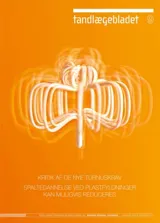Plastfyldninger med kemisk hærdende plast som liner
Introduktion – Plastmaterialer skrumper under afbinding, hvilket kan give anledning til spalter mellem tand og fyldning, spalter i tandsubstans og/eller induktion af spændinger i tand og mulig postoperativ sensibilitet. Formålet med denne undersøgelse var at afprøve, om kemisk hærdende plast anvendt som liner under lyshærdende plastfyldninger giver reduceret spaltedannelse i dentinkaviteter. Materiale og metoder – 80 dentinkaviteter blev præpareret i ekstraherede humane molarer og delt i fire grupper. Gruppe 1 blev fyldt med lyshærdende Grandio, gruppe 2 med et tyndt lag Bisfil2B (kemisk hærdende plast) og Grandio (appliceret straks og før Bisfil2B var afbundet), gruppe 3 med et tyndt lag Bisfil2B, som var afbundet før applicering af Grandio, og gruppe 4 blev fyldt udelukkende med Bisfil2B. Én forsøgsserie var uden adhæsiv, en anden var med adhæsiv. Tilstedeværelse og bredde af spalter mellem fyldning og kavitetsvæg blev påvist i lysmikroskop. Resultater – Uanset fyldningsmateriale medførte brug af adhæsiv signifikant mindre spaltedannelse. I forsøgsserien uden adhæsiv var der signifikant mindre spaltedannelse i gruppe 2 med Bisfil2B + Grandio, som blev appliceret og lyshærdet, før Bisfil2B var afbundet, end i gruppe 1 udelukkende med Grandio og gruppe 4 udelukkende med Bisfil2B. I forsøgsserien med adhæsiv var der ingen signifikant forskel i spaltedannelse mellem gruppe 1 (Grandio) og gruppe 2 (uafbundet Bisfil2B + Grandio). Gruppe 1 og 2 havde signifikant mindre spaltedannelse end gruppe 3 (afbundet Bisfil2B + Grandio) og gruppe 4 (Bisfil2B).
Composite fillings with a liner of self-curing composite: Introduction – Dental composites shrink during polymerization which can lead to gap formation between tooth and filling, gap formation in tooth substance, and/or stress induction with pos- sible postoperative symptoms. The aim of the present study was to test if a self-curing composite used as a liner reduced gap formation in light curing composite fillings in dentin cavities. Material and methods – 80 dentin cavities were prepared in extracted human molars and split into 4 groups. Group 1 was filled with light curing Grandio, group 2 with a thin layer of self- curing Bisfil2B and Grandio (applied and light cured at once and before the polymerization of Bisfil2B), group 3 with a thin layer of Bisfil2B which was allowed to polymerize before the application and light curing of Grandio, and group 4 was filled solely with Bisfil2B. One series was without and the other with adhesive. The presence and width of gaps between filling and cavity wall were determined using a light microscope. Results – Regardless of filling material the use of adhesive reduced gap formation significantly. In the experiments without adhesive there was less gap formation in group 2 with Bisfil2B + Grandio which was applied before the polymerization of Bisfil2B than in group 1 with Grandio and group 4 with Bisfil2B. In the experiments with adhesive there was no significant difference in gap formation between group 1 (Grandio) and group 2 (uncured Bisfil2B + Grandio). Group 1 and 2 had significantly less gap formation than group 3 (cured Bisfil2B + Grandio) and group 4 (Bisfil2B).


